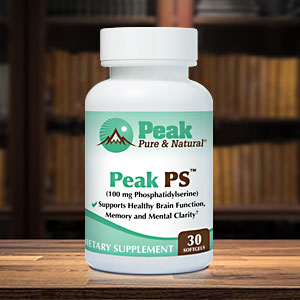Get Easy Health Digest™ in your inbox and don’t miss a thing when you subscribe today. Plus, get the free bonus report, Mother Nature’s Tips, Tricks and Remedies for Cholesterol, Blood Pressure & Blood Sugar as my way of saying welcome to the community!
The air pollutant increasing your risk for cognitive decline

Ozone is a gas that can affect our lives in good or bad ways depending on where it is in the atmosphere. For instance, the ozone layer high up in the stratosphere helps shield us from harmful solar ultraviolet (UV) radiation.
It’s the tropospheric, or ground-level, ozone that can become a problem. This ozone is a manmade air pollutant that contributes to smog. And when the ozone in outdoor air enters buildings, it reacts with the chemicals in furniture and flooring to produce toxins that can enter the lungs and cause serious breathing problems.
Ozone can affect more than the respiratory system. One study found an association between chronic ozone exposure and progressive thickening of the carotid arteries that supply blood to the head and neck, as well as a higher risk of carotid plaque. This plaque can lead to cardiovascular issues like heart attack and stroke.
And more recently, researchers at Yale School of Public Health (YSPH) examined the effect of long-term ozone exposure on brain health…
Ozone exposure may lead to cognitive impairment
The large-scale study found a link between chronic exposure to ozone and an increased risk of cognitive impairment in older adults.
While fine particulate matter in air pollution has been proven to lead to dementia and other cognitive issues, it hasn’t been clear how other pollutants can impact the brain.
So, in their study, the YSPH researchers focused on the impact of long-term ozone exposure on the cognitive abilities of nearly 10,000 older adults in China. Results showed that for every 10-microgram increase of ozone exposure per year, the risk of cognitive impairment increased by more than 10 percent. And that increase occurred regardless of other risk factors like smoking, drinking and education level.
“Our findings suggest potential benefits in delaying the progression of cognitive decline among older adults if ozone levels are reduced below the new WHO Global Air Quality Guideline for ozone pollution,” says Dr. Kai Chen, assistant professor at the Yale School of Public Health and the study’s lead author.
The researchers caution that since the data is observational, more studies are needed to explore the mechanisms behind ozone’s health impact on humans.
According to an American Lung Association report, 123 million people in the U.S. are thought to live in counties with bad ozone pollution. Approximately 18.2 million of them are 65 and older.
The YSPH researchers say their study suggests how critical it is to stem ozone exposure around the world so that healthcare systems don’t get overwhelmed amid rising pollution and the world’s aging population. And the fact that ozone pollution is projected to be getting worse under climate change makes the issue even more urgent, says Dr. Robert Dubrow, YSPH professor and study co-author.
Strategies to reduce this threat, Dubrow says, “may help maintain a higher quality of life among older adults and bring significant public health benefits to an aging society.”
Keeping ozone at bay
As with most air pollutants, it’s impossible to completely eliminate ground ozone from your environment. To reduce exposure to ozone indoors, make sure to keep your windows closed on sunny, calm days when there are high levels of ozone in the outside air.
Because ozone is a gas rather than a particle, most mechanical filters, including HEPA filters, can’t remove it from your indoor air. In fact, some types of ionizing or UV-C filters actually produce ozone as a byproduct.
But there are two types of air filters that can help with ozone…
- One study found that activated carbon particle filters installed in a commercial building’s heating, ventilating and air conditioning (HVAC) system removed 60 to 70 percent of the ozone from the air indoors roughly two to three months after installation.
- Air filtration systems using photo electrochemical oxidation (PECO) are another way to address ozone. A recent study conducted by Lawrence Berkeley National Laboratory and Molekule, a company that produces PECO air filters, found that a PECO filter placed in a room-sized chamber reduced ozone in the air to levels far lower than the EPA’s recommendation for safe exposure.
On top of that do all the other things to protect your brain from other threats to minimize overall risk. For example:
- Reduce your brain risks from other types of air pollution. A journal in Neurology study found that older women who eat one to two servings of fish per week get enough omega-3s to counteract the negative impact particulate matter air pollution has on the brain.
- Take B vitamins. A Columbia University study showed that supplementing with vitamins B6, B12 and folic acid dramatically reduced the negative impact of air pollution on DNA.
- Consider supplementing phosphatidylserine — one of the most tested nutrients for brain health and memory and a key building block for brain cells.
Editor’s note: While you’re doing all the right things to protect your brain as you age, make sure you don’t make the mistake 38 million Americans do every day — by taking a drug that robs them of an essential brain nutrient! Click here to discover the truth about the Cholesterol Super-Brain!
Sources:
Ozone Exposure Linked to Cognitive Decline in Older Adults, YSPH Study Finds — Yale School of Public Health
What is Ozone? — EPA
Chronic ozone exposure linked to heart disease, study finds — AirQualityNews.com
Ozone removal by filters containing activated carbon: a pilot study — Lawrence Berkeley National Laboratory
Evaluation of short-term initial performance of a “Molekule Air” portable air cleaner — Lawrence Berkeley National Laboratory
Ozone Removal Methods: Filters to Use in Your Home — Molekule













